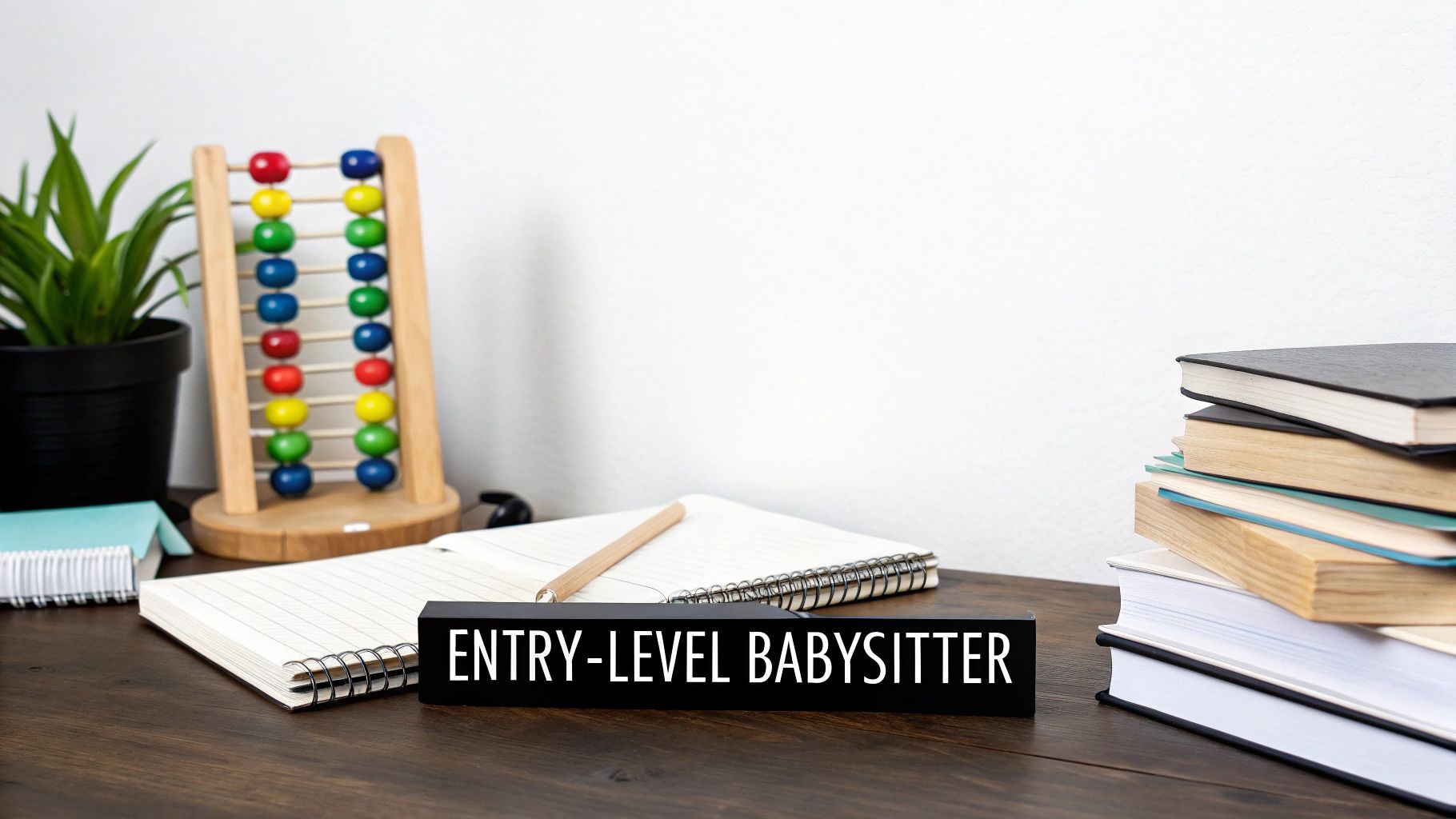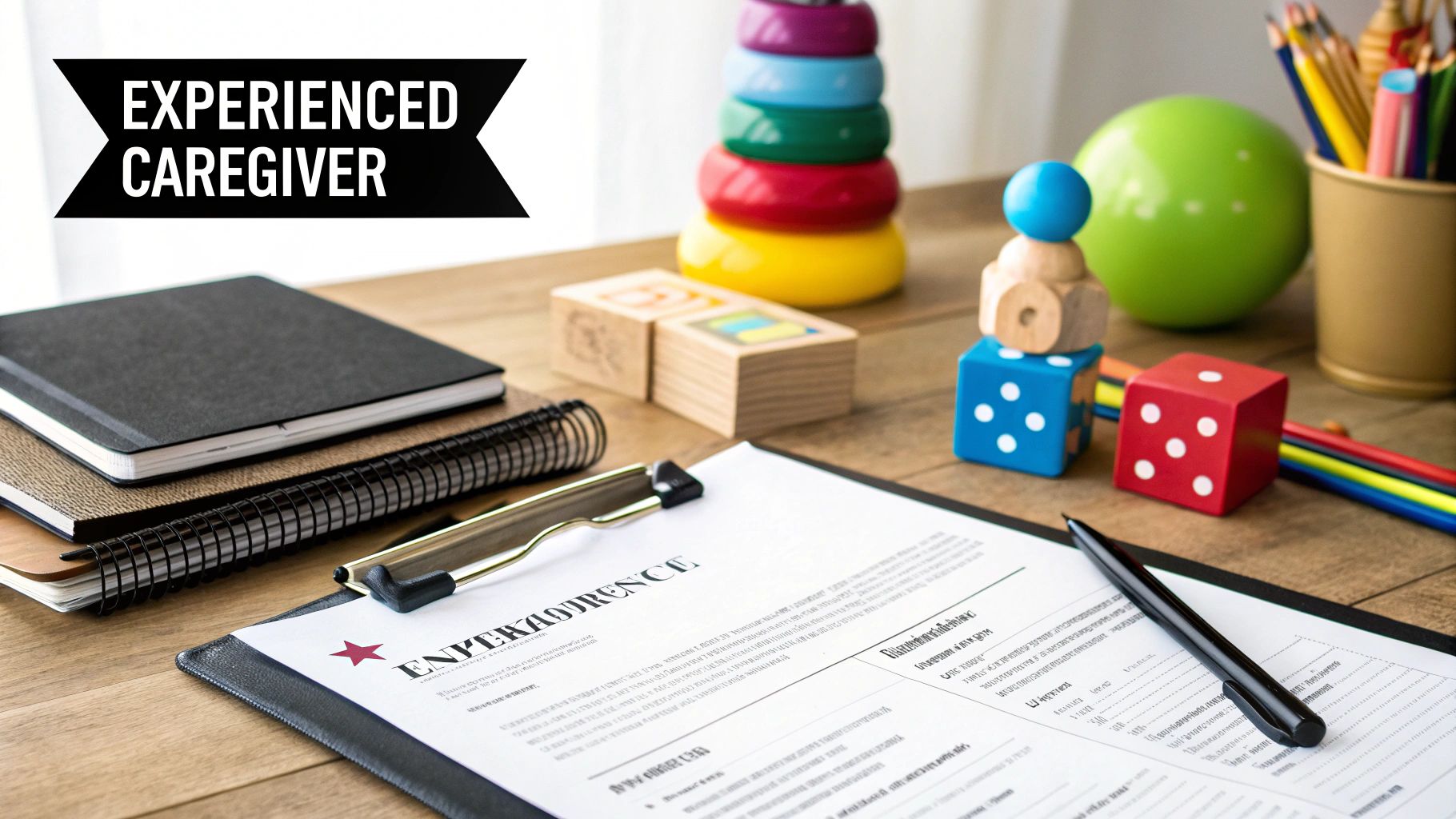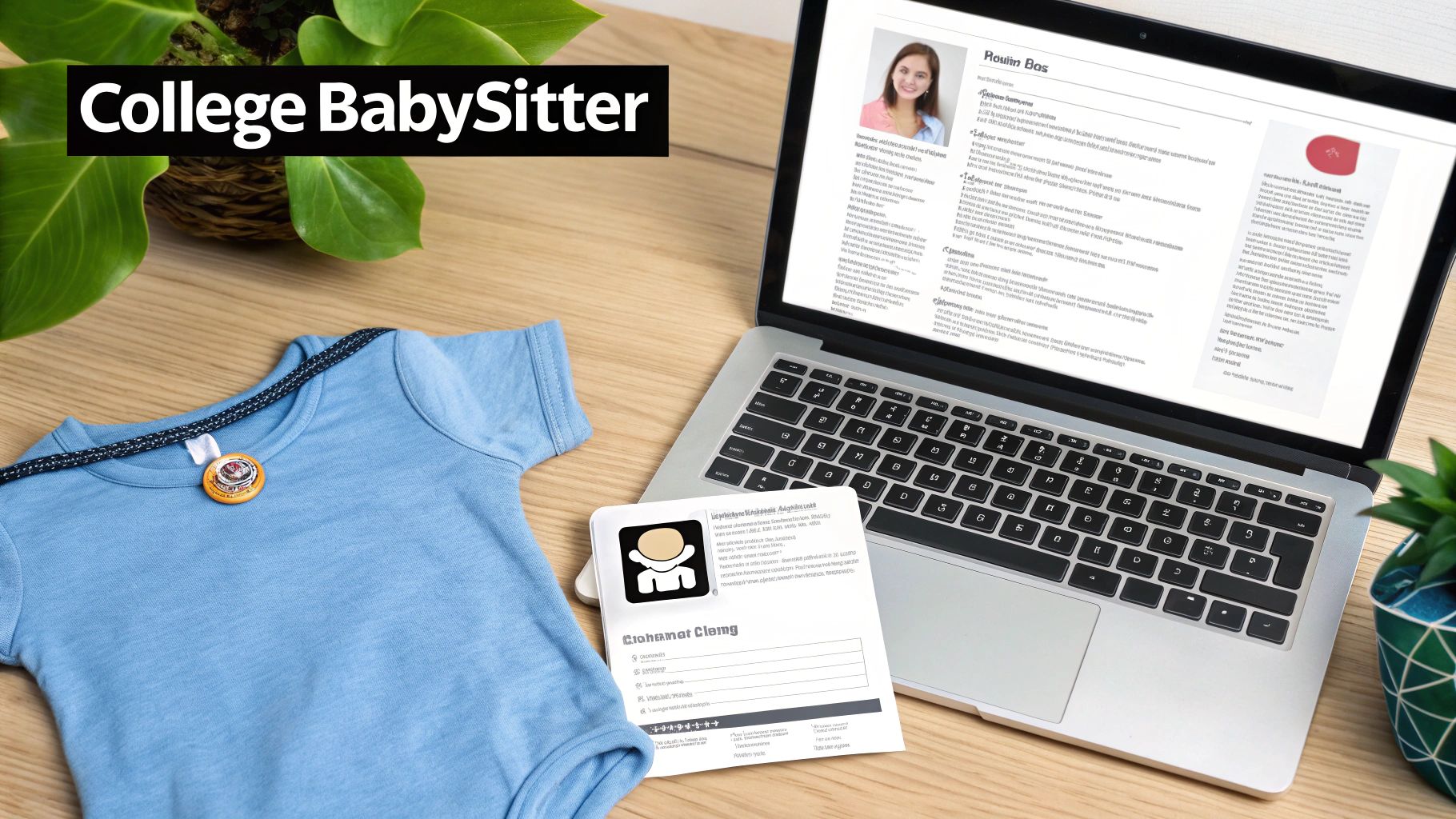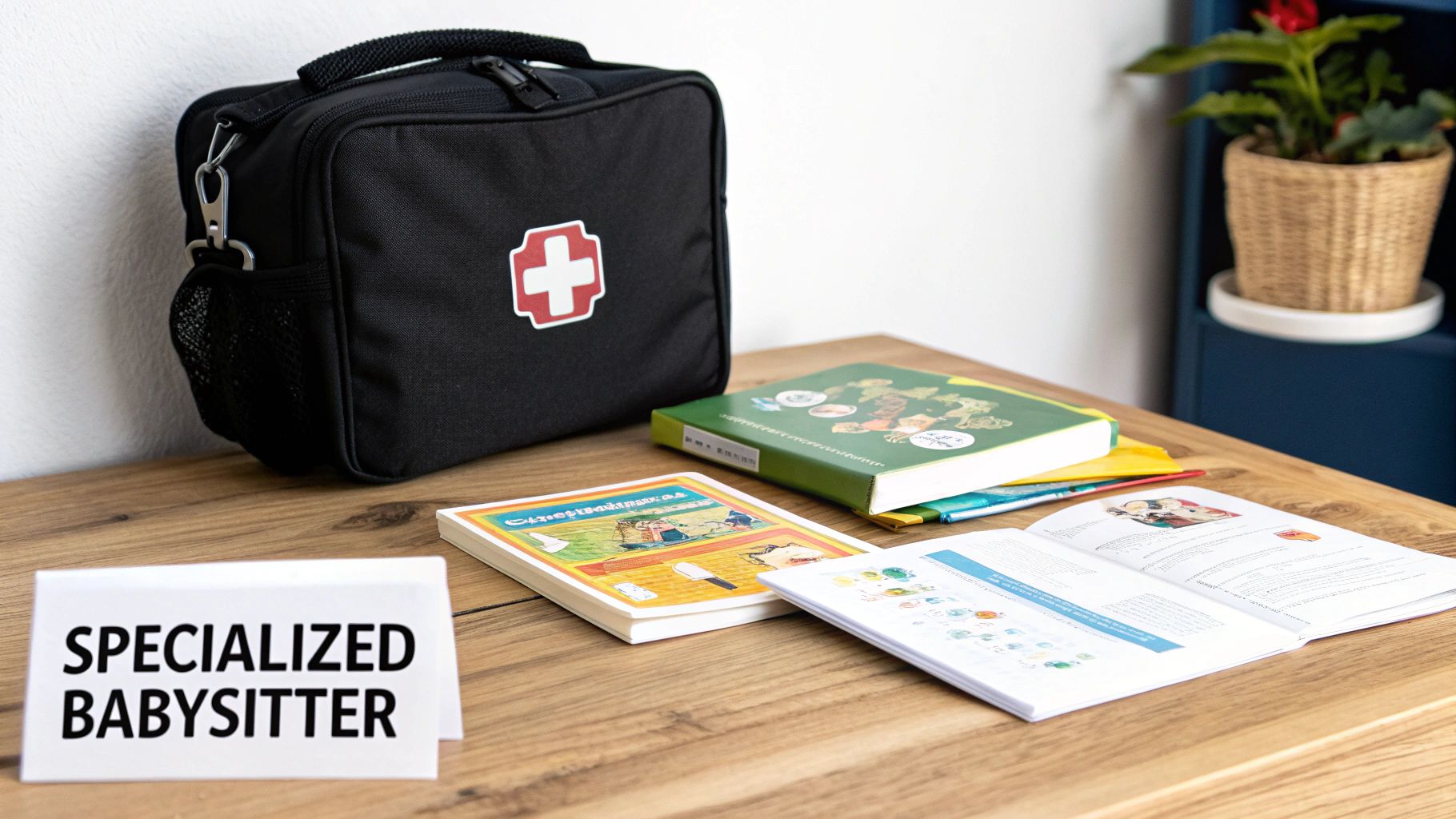Crafting a resume for a babysitting job might seem straightforward, but in a competitive market, simply listing past jobs isn't enough. A well-structured resume does more than state your experience; it tells a compelling story about your reliability, skills, and unique qualifications. It’s your primary marketing tool for convincing parents that their children will be safe, engaged, and well-cared for under your supervision. The difference between a generic resume and a strategic one can be the deciding factor in securing high-paying, long-term positions with great families.
This guide moves beyond basic templates to provide a strategic breakdown of effective babysitting resume examples. We will dissect resumes tailored for various scenarios, from the high school student with limited formal experience to the seasoned professional with specialized skills. You will learn not just what to include, but how to frame your experience to highlight your most valuable assets.
By the end of this article, you will have a clear roadmap for:
- Formatting your resume for maximum impact.
- Quantifying your accomplishments to demonstrate value.
- Tailoring your skills section to match specific job requirements.
- Transforming your resume from a simple list into a powerful tool that secures interviews.
1. High School Student Babysitter Resume
Entering the workforce as a high school student can be daunting, especially when your formal job history is limited. This is where a strategically crafted resume becomes your most powerful tool. For aspiring babysitters, the High School Student Babysitter Resume focuses on leveraging academic achievements, extracurricular involvement, and transferable skills to demonstrate responsibility, trustworthiness, and suitability for childcare, even without a long list of paid jobs. It’s one of the most essential babysitting resume examples because it addresses the common challenge of inexperience head-on.

The goal is to reframe what "experience" means. Instead of paid positions, you highlight life experiences that prove you are mature, capable, and reliable. This approach helps parents see your potential and character, which are often more important than a formal work history when it comes to caring for their children.
Strategic Analysis: Showcasing Potential Over Paychecks
The core strategy here is to translate your high school activities into compelling qualifications for a babysitting role. Parents are looking for signs of maturity, responsibility, and safety-consciousness.
- Academic Strength: Highlighting achievements like being on the honor roll or excelling in a specific subject (e.g., math tutoring) shows diligence and intelligence.
- Leadership & Teamwork: Being a team captain or club president demonstrates leadership, collaboration, and the ability to manage responsibilities, all key skills for supervising children.
- Creativity & Engagement: Participation in drama club, art, or music showcases your ability to entertain and engage children creatively, moving beyond just passive supervision.
Key Insight: Parents hiring a high school student know they aren't getting a career nanny. They are primarily looking for a responsible and energetic individual. This resume format directly addresses that by highlighting personality traits and potential demonstrated through school and community involvement.
Actionable Takeaways & Tips
To build a powerful high school babysitter resume, focus on these specific, actionable steps:
- Quantify Where Possible: Instead of saying "helped younger students," write "Tutored two 6th-grade students in pre-algebra weekly, improving their test scores by an average of 15%."
- Emphasize Safety: Mention any certifications you have, like First Aid or CPR. If you don't have them, state your willingness to get certified. This shows proactive concern for safety.
- List Relevant Coursework: Classes like Child Development, Health, or Home Economics are directly applicable and should be included in an "Education" or "Relevant Coursework" section.
- Include Informal Experience: Don't discount babysitting for younger siblings, cousins, or neighbors. Frame it professionally: "Provided after-school care for two children, ages 5 and 8, including homework assistance and meal preparation."
2. Experienced Babysitter Professional Resume
For sitters who have moved beyond occasional jobs and built a significant history of childcare, the Experienced Babysitter Professional Resume is the gold standard. This format shifts the focus from potential to proven performance. It is designed for individuals with years of experience, specialized certifications, and a track record of successful, long-term engagements with families. It's one of the most crucial babysitting resume examples as it demonstrates how to present a deep and professional work history effectively.

This resume is less about convincing parents you can do the job and more about proving you have done it exceptionally well, time and again. It details not just responsibilities but achievements, showcasing a career-oriented approach to babysitting that appeals to families seeking high-level, reliable care.
Strategic Analysis: Highlighting Expertise and Reliability
The core strategy is to present your babysitting experience with the professionalism of any other career. It’s about building a narrative of expertise, trust, and consistent, positive results.
- Detailed Work History: Instead of a simple list, each position should detail the ages of the children cared for, key responsibilities, and specific accomplishments, such as fostering developmental milestones.
- Specialized Skills: This is the place to highlight expertise that sets you apart, like experience with infants, toddlers, twins, or children with special needs. Certifications become primary qualifications, not just add-ons.
- Demonstrated Longevity: Showing long-term relationships with families (e.g., "Provided consistent care for the Smith family for over 3 years") is powerful social proof of your reliability and effectiveness.
Key Insight: Parents reviewing this type of resume are often looking for a long-term partner in their child's care. They value stability and proven skill. This resume format directly addresses this by framing your experience as a professional history, not just a series of jobs.
Actionable Takeaways & Tips
To elevate your experienced babysitter resume, focus on providing concrete evidence of your expertise:
- Quantify Your Impact: Use numbers to add weight to your experience. For example, "Managed daily schedules for three children, ages 2, 5, and 8, across 20+ hours per week" or "Cared for over 15 families in the local community."
- Create a "Key Skills" or "Core Competencies" Section: Group your most valuable skills like "Infant Care & Safety," "Early Childhood Education," "Special Needs Support," and "CPR & First Aid Certified" for quick visibility.
- Include Testimonials or a Reference Statement: Add a short, powerful quote from a previous family (with their permission) or a line like "Excellent references available upon request" to build immediate trust.
- Showcase Continuing Education: Mention any recent workshops, courses, or certifications you've completed in areas like child nutrition, positive discipline, or early literacy to demonstrate commitment to your craft.
3. College Student Babysitter Resume
For college students juggling academics and part-time work, a babysitter resume needs to strike a perfect balance. It must showcase growing professionalism and academic knowledge while highlighting practical childcare experience. This resume moves beyond the potential-focused approach of a high school student, demonstrating a higher level of maturity, responsibility, and specialized knowledge. This is one of the most versatile babysitting resume examples as it bridges the gap between youthful enthusiasm and emerging professional expertise.

The primary goal is to show parents that your college education directly enhances your babysitting skills. Whether you're studying child psychology or are a pre-med student with first aid training, your academic pursuits are a significant asset. This resume format helps you articulate how your studies make you a more informed, capable, and trustworthy caregiver.
Strategic Analysis: Connecting Academics to Application
The core strategy is to draw clear, direct lines between your coursework and the practical demands of childcare. Parents hiring a college student expect more than just supervision; they look for someone who can contribute to their child's development.
- Major-Specific Skills: An Education major can highlight lesson planning skills, while a Psychology student can emphasize understanding of child behavior and developmental milestones.
- Time Management & Reliability: Successfully managing a demanding college course load while working proves you possess exceptional organizational and time management skills, crucial for handling a child's schedule.
- Increased Professionalism: Including campus jobs, volunteer work, or internships demonstrates a higher level of responsibility and commitment than a typical high school applicant.
Key Insight: Parents see a college student as an investment in their child's well-being and development. Your resume should position you not just as a sitter, but as a positive role model and a knowledgeable caregiver who can apply academic insights in a real-world setting.
Actionable Takeaways & Tips
To create a compelling college student babysitter resume, integrate your academic and practical experiences:
- Create a "Relevant Coursework" Section: List specific classes like Child Development, Educational Psychology, Pediatric First Aid, or Nutrition. This immediately shows parents your theoretical foundation.
- Detail Your Time Management Skills: Frame your ability to balance work and school as a key strength. For example: "Successfully managed a 15-credit course load while providing 10-15 hours of weekly childcare."
- Showcase Academic Projects: Mention projects, papers, or presentations related to child development or education. This serves as concrete proof of your interest and expertise.
- Leverage Campus Involvement: Include roles in campus organizations, work-study positions, or tutoring experiences. These positions reinforce your reliability and interpersonal skills.
4. Career-Changer Babysitter Resume
Transitioning from a professional field into childcare requires a resume that skillfully bridges the gap between past experience and future aspirations. The Career-Changer Babysitter Resume is designed for professionals, such as former teachers, healthcare workers, or retirees, who are seeking to leverage their extensive life and work skills in a childcare setting. This template is one of the most compelling babysitting resume examples because it shows parents that professional-grade skills are highly relevant and valuable for ensuring their children’s safety, development, and well-being.

The primary objective is to reframe your professional history, translating corporate, educational, or medical competencies into direct childcare benefits. Instead of focusing on industry-specific achievements, you highlight the underlying transferable skills like crisis management, communication, and organization that are universally sought after by parents.
Strategic Analysis: Translating Professionalism into Childcare Excellence
The strategy here is to build a narrative of unparalleled reliability and expertise. Parents reviewing this resume should see a candidate who brings a level of maturity and capability far beyond typical applicants.
- Highlight Transferable Skills: A former project manager's organizational skills are perfect for managing multiple children's schedules. A nurse's medical background provides incredible peace of mind regarding health and safety.
- Emphasize Maturity and Reliability: Your professional history is proof of your dependability, punctuality, and ability to handle responsibility. This isn't just a job; it's a professional service you are offering.
- Showcase Specialized Knowledge: A retired teacher can offer tutoring and educational enrichment. A healthcare worker can provide care for children with special medical needs. This specialized value proposition is a key differentiator.
Key Insight: Parents are not just hiring a babysitter; they are entrusting their children to someone. A career-changer's resume provides a powerful argument for trust by showcasing a proven track record of professional conduct and specialized skills that directly enhance a child's safety and development.
Actionable Takeaways & Tips
To create a persuasive career-changer resume, focus on making clear connections between your past and your new childcare goals:
- Create a "Summary of Qualifications": Start your resume with a brief summary that explicitly connects your professional background to childcare. For example: "Former registered nurse with 10+ years of pediatric experience, now seeking to provide exceptional in-home childcare with a focus on health and safety."
- Translate Job Duties: Rephrase your past responsibilities. "Managed a team of five" becomes "Supervised and guided a small group, ensuring tasks were completed safely and efficiently." "Developed client presentations" becomes "Created engaging and educational activities for diverse age groups."
- Highlight Relevant Certifications: Go beyond basic First Aid. Certifications in nursing (RN, LPN), teaching, or even project management (PMP) can be framed to show a high level of competence and training.
- Address the "Why": Briefly mention your motivation for changing careers in your cover letter or professional summary. A genuine passion for working with children adds an essential human element to your professional profile.
5. Specialized Skills Babysitter Resume
When your caregiving abilities go beyond the standard, your resume needs to reflect that expertise. The Specialized Skills Babysitter Resume is designed for individuals who offer more than just supervision; they bring a unique talent or qualification to the table, such as special needs experience, language immersion, or tutoring. This format moves beyond a generalist approach to position you as a specialist. It is one of the most critical babysitting resume examples for professionals seeking higher pay rates and families with specific requirements.
The goal of this resume is to immediately signal your unique value proposition to a niche market. Whether you have experience with children on the autism spectrum, are fluent in another language, or can provide music lessons, this resume structure helps you command attention and justify a premium rate. It’s about marketing yourself not just as a caregiver, but as an enriching addition to a child’s development.
Strategic Analysis: Highlighting Niche Expertise
The core strategy is to front-load your resume with your specialization, making it the central theme. Parents seeking these specific skills don't want to hunt for them; they need to see your qualifications immediately.
- Dedicated Skills Section: Create a prominent section at the top, right under your summary, titled "Specialized Skills" or "Areas of Expertise" to list qualifications like "Autism Spectrum Care," "Bilingual (Spanish/English)," or "Musical Instruction (Piano)."
- Evidence-Based Experience: Every point in your experience section should reinforce your specialty. For instance, instead of "Played with children," a special needs babysitter might write, "Implemented sensory-friendly activities to support developmental goals for a child with ASD."
- Certifications as Proof: Your certifications are your credentials. Highlight things like an ABA Technician certificate, a TEFL qualification, or music school credentials prominently to validate your expertise.
Key Insight: Families looking for specialized care are often willing to pay more, but they require a higher level of trust and proof of competence. This resume format is designed to build that trust quickly by showcasing verified skills and relevant, specific experience.
Actionable Takeaways & Tips
To create a powerful specialized skills babysitter resume, focus on these targeted actions:
- Customize Your Title: Change your resume title from "Babysitter" to something more specific, like "Special Needs Care Provider" or "Bilingual Childcare Specialist."
- Use Keywords from Job Postings: Look at postings for specialized care roles and incorporate their language. If they ask for "experience with non-verbal cues," make sure your resume includes that phrase.
- Show, Don't Just Tell: Instead of saying you're a great music tutor, write, "Taught basic piano to a 7-year-old, culminating in their ability to play three simple songs independently within two months."
- List All Relevant Training: Include workshops, online courses, or seminars related to your specialty, even if they didn't result in a formal certification. It demonstrates a commitment to continuous learning in your niche.
6. Summer Camp Counselor to Babysitter Resume
Transitioning from a summer camp counselor to a private babysitter is a natural career progression, but your resume needs to bridge the gap effectively. A camp environment involves structured, group-based supervision, while private babysitting requires more autonomous, family-specific care. This resume format is designed to translate your high-volume, dynamic camp experience into qualifications that appeal to parents seeking reliable, one-on-one childcare. It stands out among babysitting resume examples because it showcases a wealth of hands-on experience that is directly transferable.
The purpose of this resume is to reframe your camp counselor duties to highlight individual responsibility and adaptability. You need to show parents that you can manage not just a group of 15 kids during a planned activity, but also their two children during a quiet evening at home. This involves emphasizing skills like safety protocol, activity planning, and behavior management in a more personalized context.
Strategic Analysis: Translating Group Management to In-Home Care
The central strategy is to distill your large-scale camp experiences into skills relevant to a home setting. Parents aren’t just hiring an activity leader; they are entrusting their children and home to you. Your resume must prove you are proficient in both structured engagement and independent, responsible supervision.
- From Group Leader to Personal Mentor: Your experience managing a cabin of ten kids or leading a sports activity for twenty translates into an ability to handle multiple children, mediate conflicts, and maintain a positive environment.
- Safety and Protocol: Camp counselors receive rigorous training in emergency procedures, first aid, and specific protocols (e.g., for allergies or medical needs). Highlighting this formal training immediately builds trust and credibility.
- Structured Creativity: Your experience planning and executing daily camp schedules, from arts and crafts to nature walks, demonstrates your ability to keep children engaged and entertained without relying on screens.
Key Insight: Parents value the formal training and high-energy environment of camp life. This resume’s strength lies in showing that you can bring that same level of professionalism, safety-consciousness, and creative engagement into their home, tailored specifically to their children’s needs.
Actionable Takeaways & Tips
To effectively adapt your camp counselor experience for a babysitting resume, concentrate on these specific actions:
- Highlight Age Group Specialization: Be specific. Instead of "worked with children," state "Supervised and mentored a group of 12 campers, ages 6-8, for three consecutive summers." This helps parents find a match for their kids.
- Detail Safety and Emergency Training: Create a dedicated "Certifications" or "Skills" section to list CPR, First Aid, and any camp-specific safety training. Mention your role in enforcing safety rules.
- Showcase Activity Planning: Quantify your planning skills. For example: "Designed and led over 50 unique arts and crafts projects for groups of up to 20 campers" or "Organized weekly sports tournaments for the entire junior camp division."
- Emphasize Independent Responsibility: While you worked in a team, pull out examples of your autonomy. Mention duties like "Conducted nightly wellness checks for a cabin of 8 campers" or "Managed individual behavioral plans for children with specific needs."
Babysitting Resume Types Comparison
| Babysitter Resume Type | Implementation Complexity 🔄 | Resource Requirements ⚡ | Expected Outcomes 📊 | Ideal Use Cases 💡 | Key Advantages ⭐ |
|---|---|---|---|---|---|
| High School Student Babysitter | Low – simple format focusing on academics and skills | Minimal – no certifications required | Moderate – shows potential, but limited experience | Beginners, teens new to babysitting | Highlights eagerness, transferable skills, and responsibility |
| Experienced Babysitter Professional | High – detailed work history and certifications | High – requires certifications and documented achievements | High – proven track record, trusted by parents | Seasoned babysitters with extensive work history | Demonstrates reliability, commands higher rates, builds trust |
| College Student Babysitter | Medium – balance between academics and childcare experience | Moderate – relevant coursework and work experience | Moderate to high – maturity and academic background valued | Part-time sitters balancing school and work | Shows responsibility, flexibility, and relevant education |
| Career-Changer Babysitter | Medium to high – integrating professional experience with childcare | Moderate – professional work history adapted to babysitting | High – mature approach, strong transferable skills | Professionals transitioning to childcare | Brings maturity, problem-solving skills, and reliability |
| Specialized Skills Babysitter | High – focus on certifications and specialized expertise | High – extensive training and equipment needed | Very high – premium rates, specialized client base | Babysitters with special needs or niche expertise | Commands premium rates, strong professionalism, client loyalty |
| Summer Camp Counselor to Babysitter | Medium – emphasizes transferable group childcare and activity planning | Moderate – relies on prior camp experience and safety training | Moderate – group management skills adapted to individual care | Former camp counselors moving to babysitting | Demonstrates leadership, creativity, emergency response skills |
Key Takeaways: Building Your Perfect Babysitting Resume
Crafting a compelling babysitting resume is your first step toward landing great jobs with families you’ll love working for. As we've explored through the various babysitting resume examples, from the high school student just starting out to the seasoned childcare professional, the core principle remains the same: showcase your unique value and build trust before you even meet. Your resume is more than a document; it's a marketing tool that tells a story about your responsibility, skills, and dedication to providing excellent care.
Remember, every family is looking for someone they can depend on. Your resume needs to communicate that reliability clearly and professionally. By strategically highlighting your experiences and qualifications, you transform from just another applicant into the ideal candidate they’ve been searching for.
Synthesizing the Strategies
Throughout our analysis of different babysitting resume examples, several key themes emerged. Mastering these concepts will give you a significant advantage.
- Quantify Your Accomplishments: Don't just list duties; demonstrate impact. Instead of "Cared for children," write "Supervised 3 children aged 4-9, managing after-school schedules, homework assistance, and meal preparation." Numbers provide concrete evidence of your capabilities.
- Tailor for the Target: One size does not fit all. Customize your resume for each application. If a family mentions needing help with homework, highlight your tutoring experience or academic strengths. This shows you’ve read their ad carefully.
- Lead with Your Strengths: Your resume’s structure should play to your strengths. If you're a high school student with limited formal experience but extensive volunteer work with kids, your "Volunteer Experience" section might be more prominent than for a career professional.
Actionable Next Steps to Build Your Resume
Now it’s time to put these insights into practice. Follow these steps to create a standout document that gets results.
- Choose Your Foundation: Select the resume example from this article that most closely matches your background. Use it as a structural template, not a word-for-word copy.
- Brainstorm Your Experience: List everything you've done related to childcare, responsibility, and safety. This includes formal jobs, informal babysitting for neighbors, volunteer work, relevant school projects, and certifications.
- Translate Duties into Achievements: Go through your brainstormed list and add metrics and specific outcomes to each point. Focus on what you achieved, not just what you did.
- Proofread Meticulously: A resume with typos or grammatical errors sends the wrong message. Read it aloud, use a spell checker, and ask a friend or family member to review it for you. A polished document signals professionalism and attention to detail.
By following this strategic approach, you're not just filling out a template; you're building a powerful argument for why you are the best choice. This effort demonstrates your commitment and sets the stage for a successful and rewarding babysitting career.
Ready to organize your thoughts and craft the perfect resume? TNote can help you brainstorm experiences, outline your sections, and keep track of your applications all in one place. Use TNote to turn the powerful strategies from these babysitting resume examples into your own job-winning document with ease.